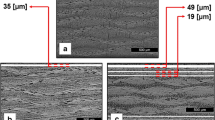Abstract
The internal friction spectra of cured epoxy T-107 and a fiberglass reinforced plastic based on it are studied. In the temperature dependence of mechanical losses, β and γ relaxation maxima are found below the glass transition temperature with activation energies of Eβ = 0.30 ± 0.05 eV and Eγ = 0.18 ± 0.04 eV, respectively. The first maximum is associated with the vibrations of the defective oxygen atoms of the epoxy groups of the polymer network, and the second maximum is attributed to the vibrations of the lateral OH groups of the main polymer network. The internal friction of the epoxy polymer in the region of α relaxation process has been studied. In this region, two segments with an intersection point at the glass transition temperature are seen in the temperature dependence of the internal friction in coordinates lnQ−1 vs. 1/T. The high temperature segment of the internal friction background is used to estimate the energies of migration and formation of vacancy-like defects in the amorphous matrix of glass reinforced plastics, which are associated with delocalized oxygen and equal to Em = 0.72 ± 0.05 eV and Ev = 1.41 ± 0.06 eV, respectively.




Similar content being viewed by others
REFERENCES
T. V. Tropin, Ju. W. P. Schmelzer, and V. L. Aksenov, Phys.-Usp. 59, 42 (2016).
D. V. Novikov, Phys. Solid State 63, 154 (2021).
S. V. Nemilov and Yu. S. Balashov, Glass Phys. Chem. 42, 119 (2016).
E. N. Kablov, Herald Russ. Acad. Sci. 82, 158 (2012).
E. V. Prut, L. A. Zhorina, D. D. Novikov, A. Y. Gorenberg, L. V. Vladimirov, and A. A. Berlin, Mendeleev Commun. 27, 405 (2017).
V. A. Zhuikov, Y. V. Zhuikova, T. K. Makhina, V. L. Myshkina, G. A. Bonartseva, A. P. Bonartsev, A. Rusakov, A. Useinov, V. V. Voinova, A. A. Berlin, and A. L. Iordanskii, Polymers 12, 728 (2020).
I. A. Timoshkin, V. V. Aleshkevich, E. S. Afanas’eva, B. A. Bulgakov, A. V. Babkin, A. V. Kepman, and V. V. Avdeev, Polym. Sci., Ser. C 62, 172 (2020).
N. N. Trofimov, M. Z. Kanovich, E. M. Kartashov, V. I. Natrusov, A. T. Ponomarenko, V. G. Shevchenko, V. I. Sokolov, I. D. Simonov-Emel’yanov, Physics of Composite Materials, Two Volumes (Mir, Moscow, 2005) [in Russian].
G. M. Bartenev, Polym. Sci., Ser. B 43, 202 (2001).
S. A. Mazurina, I. D. Simonov-Emel’yanov, V. A. Lomovskoy, M. R. Kiselev, and N. Y. Konstantinov, Inorg. Mater.: Appl. Res. 10, 174 (2019).
G. M. Bartenev and A. G. Barteneva, Relaxation Properties of Polymers (Khimiya, Moscow, 1992) [in Russian].
T. R. Aslamazova, V. I. Zolotarevskii, V. A. Kotenev, N. Y. Lomovskaya, V. A. Lomovskoi, and A. Y. Tsivadze, Prot. Met. Phys. Chem. Surf. 54, 1081 (2018).
V. A. Lomovoskoi, N. A. Abaturova, N. Yu. Lomovskaya, O. A. Khlebnikova, and T. B. Galushko, Polym. Sci., Ser. A 60, 284 (2018).
G. Bartenev, L. A. Shelkovnikova, and L. A. Akopyan, Polym. Mech. 9, 133 (1973).
Yu. E. Kalinin, A. T. Kosilov, O. V. Ovdak, A. M. Kudrin, O. A. Karaeva, M. A. Kashirin, and D. Ya. Degtyarev, Tech. Phys. 64, 535 (2019).
Epoxy Prepreg. https://www.inumit.ru/img/file/t107.pdf. Cited 2021.
S. A. Gridnev, I. I. Popov, M. A. Kashirin, and A. I. Bocharov, J. Alloys Compd. 889, 161764 (2021).
V. A. Rabinovich and Z. Ya. Khavin, Concise Handbook of Chemistry (Khimiya, Leningrad, 1978) [in Russian].
G. M. Bartenev, Structure and Relaxation Properties of Polymers (Khimiya, Moscow, 1979) [in Russian].
V. A. Lomovskoi, N. A. Abaturova, N. Y. Lomovskaya, T. B. Galushko, and V. I. Zolotarevskii, Polym. Sci., Ser. A 61, 491 (2019).
G. M. Bartenev and V. A. Lomovskoi, Polym. Sci., Ser. A 44, 841 (2002).
V. A. Lomovskoi, Tonkie Khim. Tekhnol. 10 (3), 8 (2015).
A. S. Novick and B. S. Berry, Anelastic Relaxation in Crystalline Solids (Academic Press, New York; London, 1972).
D. S. Sanditov, J. Exp. Theor. Phys. 123, 429 (2016).
D. S. Sanditov and M. I. Ojovan, Phys. -Usp. 62, 111 (2019).
D. S. Sanditov, Dokl. Phys. Chem. 464, 255 (2015).
I. V. Zolotukhin, Yu. E. Kalinin, and O. V. Stognei, New Directions in Physical Materials Science (Voronezhskii Gos. Univ., Voronezh, 2000) [in Russian].
D. S. Sanditov and A. A. Mashanov, Polym. Sci., Ser. A 61, 119 (2019).
I. V. Zolotukhin and Yu. E. Kalinin, Fiz. Tverd. Tela 37, 536 (1995).
Y. E. Kalinin and B. M. Darinskii, Met. Sci. Heat Treat 54, 221 (2012).
Chemical Bond Dissociation Energy: Ionizating Potential and Electron Affinity, Ed. by V. N. Kondrat’ev (Nauka; Inst. Khim. Fiz.; Inst. Vysokikh Temp., Moscow, 1974) [in Russian].
R. A. De Souza, in Resistive Switching from Fundamentals of Nanoionic Redox Processes to Memristive Device Applications, Ed. by D. Ielmini and R. Waser (Wiley, Weinheim, 2016), p. 125.
A. Mehonic, A. J. Kenyon, A. L. Shluger, D. Gao, I. Valov, E. Miranda, D. Ielmini, A. Bricalli, E. Ambrosi, C. Li, J. J. Yang, and Q. Xia, Adv. Mater. 30, 1801187 (2018).
ACKNOWLEDGMENTS
The authors are grateful to V.V. Avdeev and A.V. Kepman for providing the initial components for the preparation of samples and useful discussions, and to A.I. Bocharov for performing experiments on a scanning electron microscope.
Funding
This study was financially supported by the Ministry of Science and Higher Education within the basic part of State assignment (project no. FZGM-2020-007).
Author information
Authors and Affiliations
Corresponding author
Ethics declarations
The authors declare that they have no conflicts of interest.
Additional information
Translated by O. Kadkin
Rights and permissions
About this article
Cite this article
Kalinin, Y.E., Kudrin, A.M., Ovdak, O.V. et al. Internal Friction in an Epoxy Polymer and a Fiberglass Reinforced Plastic Based on It. Polym. Sci. Ser. A 64, 1–9 (2022). https://doi.org/10.1134/S0965545X22010047
Received:
Revised:
Accepted:
Published:
Issue Date:
DOI: https://doi.org/10.1134/S0965545X22010047




